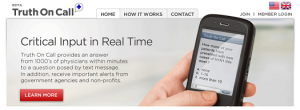M-Health: Smart Band-aids, Telemedicine, and Crowdsourced Physiological Data

During the TEDMED conference last October, leading cardiologist Eric Topol led a talk on how consumer mobile devices are revolutionizing healthcare. He describes the alignment of certain technologies and how they have sparked a "perfect positive storm," one that will change the way we think about our bodies. 4 billion cell phone users, broadband 3G, pervasive connectivity, smartphones, and ingenious sensors are responsible for unlocking this wave of innovation.
Topol talks about shrinking and evermore accurate sensors, those that can be attached to our bodies. For some of us, products like Nike+, Fitbit, and S2H Replay come to mind. These "smart band-aids" are able to talk wirelessly with a gateway, also known as our mobile phone. Once reaching the mobile phone, captured physiological metrics can be sent off into the cloud and then to the physician. There it can be analyzed and sent back to a patient -- closing the feedback loop.
Physicians are already able to remotely observe a patient's vital signs via mobile screen. Expectant parents have the ability to continuously monitor fetal heart rate and intrauterine contractions. We will be able to track every minute of our sleep, and visually display different states (wake, REM, light, or deep). Sleep Cycle is an extremely rudimentary example of this, already available for the iPhone. Topol even presents a handheld ultrasound. This trend towards tracking every facet of life (the quantified self or personal analytics) is tied to a philosophy Wired defines as Knowing Thyself.
Topol continues to explain how small changes in the healthcare system could not only help patients, but would also save institutions money. A device that can measure the seven vital signs for someone with heart failure could reduce the need for expensive hospital beds. The decentralizing effect that tethered Internet devices (desktop computers) has already had on hospitals could continue with the ability to observe patient vital signs while on-the-go. It could go as far as causing hospital architecture to evolve. In City of Bits, William J. Mitchell describes how telemedicine "makes old-style assemblies of patients around specialized medical facilities less necessary." Therefore, less of a need for the traditional hospital room.
With the help of medical sensors, mobile phones will continue to become a smart extension of our bodies, knowing more about ourselves than we do. With constant connectivity, imagine our personal physiological stats being uploaded to a cloud, along with everyone else's. Viewing our own vital signs is one thing, but the possibilities that come with crowdsourcing mobile physiological stats are huge and could lead to discovery.
Watch Eric Topol's talk here:
-
http://www.mamk.net MAMK
-
http://www.mamk.net MAMK
-
http://instructionaldesignfusions.wordpress.com/2010/09/30/qr-codes-augmented-reality-and-learning-for-health/ QR Codes, Augmented Reality, and Learning for Health | Instructional Design Fusions
-
http://teamstersonline.com/forums/trades-division/27903-green-projects-4.html#post182519 GREEN Projects – Page 4 – TeamstersOnline








